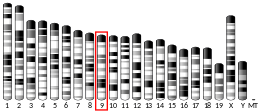GLCE
D-glucuronyl C5-epimerase is an enzyme that in humans is encoded by the GLCE gene.[5][6]
| GLCE | |||||||||||||||||||||||||
|---|---|---|---|---|---|---|---|---|---|---|---|---|---|---|---|---|---|---|---|---|---|---|---|---|---|
| Identifiers | |||||||||||||||||||||||||
| Aliases | GLCE, HSEPI, glucuronic acid epimerase | ||||||||||||||||||||||||
| External IDs | OMIM: 612134 MGI: 2136405 HomoloGene: 14111 GeneCards: GLCE | ||||||||||||||||||||||||
| |||||||||||||||||||||||||
| |||||||||||||||||||||||||
| Orthologs | |||||||||||||||||||||||||
| Species | Human | Mouse | |||||||||||||||||||||||
| Entrez | |||||||||||||||||||||||||
| Ensembl | |||||||||||||||||||||||||
| UniProt | |||||||||||||||||||||||||
| RefSeq (mRNA) | |||||||||||||||||||||||||
| RefSeq (protein) | |||||||||||||||||||||||||
| Location (UCSC) | Chr 15: 69.16 – 69.27 Mb | Chr 9: 62.06 – 62.12 Mb | |||||||||||||||||||||||
| PubMed search | [3] | [4] | |||||||||||||||||||||||
| Wikidata | |||||||||||||||||||||||||
| |||||||||||||||||||||||||
References
- GRCh38: Ensembl release 89: ENSG00000138604 - Ensembl, May 2017
- GRCm38: Ensembl release 89: ENSMUSG00000032252 - Ensembl, May 2017
- "Human PubMed Reference:". National Center for Biotechnology Information, U.S. National Library of Medicine.
- "Mouse PubMed Reference:". National Center for Biotechnology Information, U.S. National Library of Medicine.
- Ghiselli G, Agrawal A (Aug 2005). "The human D-glucuronyl C5-epimerase gene is transcriptionally activated through the β-catenin–TCF4 pathway". Biochem J. 390 (Pt 2): 493–9. doi:10.1042/BJ20050152. PMC 1198929. PMID 15853773.
- "Entrez Gene: GLCE glucuronic acid epimerase".
Further reading
- Grigorieva E, Eshchenko T, Rykova VI, et al. (2008). "Decreased expression of human D-glucuronyl C5-epimerase in breast cancer". Int. J. Cancer. 122 (5): 1172–6. doi:10.1002/ijc.23203. PMID 17985344.
- Hagner-McWhirter A, Li JP, Oscarson S, Lindahl U (2004). "Irreversible glucuronyl C5-epimerization in the biosynthesis of heparan sulfate". J. Biol. Chem. 279 (15): 14631–8. doi:10.1074/jbc.M313760200. PMID 14718527.
- Ota T, Suzuki Y, Nishikawa T, et al. (2004). "Complete sequencing and characterization of 21,243 full-length human cDNAs". Nat. Genet. 36 (1): 40–5. doi:10.1038/ng1285. PMID 14702039.
- Strausberg RL, Feingold EA, Grouse LH, et al. (2003). "Generation and initial analysis of more than 15,000 full-length human and mouse cDNA sequences". Proc. Natl. Acad. Sci. U.S.A. 99 (26): 16899–903. doi:10.1073/pnas.242603899. PMC 139241. PMID 12477932.
- Crawford BE, Olson SK, Esko JD, Pinhal MA (2001). "Cloning, Golgi localization, and enzyme activity of the full-length heparin/heparan sulfate-glucuronic acid C5-epimerase". J. Biol. Chem. 276 (24): 21538–43. doi:10.1074/jbc.M100880200. PMID 11279150.
- Li JP, Gong F, El Darwish K, et al. (2001). "Characterization of the D-glucuronyl C5-epimerase involved in the biosynthesis of heparin and heparan sulfate". J. Biol. Chem. 276 (23): 20069–77. doi:10.1074/jbc.M011783200. PMID 11274177.
- Nagase T, Ishikawa K, Suyama M, et al. (1999). "Prediction of the coding sequences of unidentified human genes. XII. The complete sequences of 100 new cDNA clones from brain which code for large proteins in vitro". DNA Res. 5 (6): 355–64. doi:10.1093/dnares/5.6.355. PMID 10048485.
- Hillier LD, Lennon G, Becker M, et al. (1997). "Generation and analysis of 280,000 human expressed sequence tags". Genome Res. 6 (9): 807–28. doi:10.1101/gr.6.9.807. PMID 8889549.
This article is issued from Wikipedia. The text is licensed under Creative Commons - Attribution - Sharealike. Additional terms may apply for the media files.



